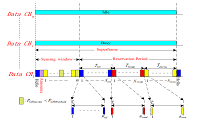A Multichannel MAC Protocol for IoT-enabled Cognitive Radio Ad Hoc Networks
DOI:
https://doi.org/10.46604/aiti.2020.3946Keywords:
internet of things IoT, medium access control, cognitive radio ad hoc networks, multichannel, MAC, contention-freeAbstract
Cognitive radios have the ability to dynamically sense and access the wireless spectrum, and this ability is a key factor in successfully building Internet-of-Things (IoT)-enabled mobile ad hoc networks. This paper proposes a contention-free token-based multichannel MAC protocol for IoT-enabled Cognitive Radio Ad Hoc Networks (CRAHNs). In this, secondary users of CRAHNs detect activity on the wireless spectrum and then access idle channels licensed by primary users. CRAHNs are divided into clusters, and the channel to use for transmission is determined dynamically from the probability of finding idle primary-user channels. The token-based MAC window size is adaptive, with adjustment according to actual traffic, which reduces both end-to-end MAC contention delay and energy consumption. High throughput and spatial reuse of channels can also be achieved using a dynamic control channel and dynamic schemes for contention windows. We performed extensive simulations to verify that the proposed method can achieve better performance in mobile CRAHNs than other MAC schemes can.
References
A. A. Khan, M. H. Rehmani, and A. Rachedi, “Cognitive-radio-based internet of things: applications, architectures, spectrum related functionalities, and future research directions,” IEEE Transactions on Wireless Communications, vol. 24, no. 3, pp. 17-25, June 2017.
J. Gubbi, R. Buyya, S. Marusic, and M. Palaniswami, “Internet of things (IoT): a vision, architectural elements, and future directions,” Future Generation Computer System, vol. 29, no. 7, pp. 1645-1660, September 2013.
H. Nishiyama, T. Ngo, S. Oiyama, and N. Kato, “Relay by smart device: Innovative communications for efficient information sharing among vehicles and pedestrians,” IEEE Transactions on Vehicular Technology Magazine, vol. 10, no. 4, pp. 54-62, December 2015.
J. Liu and N. Kato, “A markovian analysis for explicit probabilistic stopping-based information propagation in post disaster ad hoc mobile networks,” IEEE Transactions on Wireless Communications, vol. 15, no. 1, pp. 81-90, January 2016.
P. Wang, H. Jiang, and W. Zhuang, “Capacity improvement and analysis for data/data traffic over WLANs,” IEEE Transactions on Wireless Communications, vol. 6, no. 4, pp. 1530-1541, May 2007.
J. Sobrinho and A. Krishnakumar, “Quality-of-service in ad hoc carrier sense multiple access wireless networks,” IEEE Journal on Selected Areas in Communications, vol. 17, no. 8, pp. 1353-1368, August 1999.
P. Wang and W. Zhuang, “A collision-free MAC scheme for multimedia wireless mesh backbone,” IEEE Transactions on Wireless Communications, vol. 8, no. 7, pp. 3577-3589, 2009.
S. Jiang, J. Rao, D. He, X. Ling, and C. C. Ko, “A simple distributed PRMA for MANETs,” IEEE Transactions on Vehicular Technology, vol. 51, no. 2, pp. 293-305, March 2002.
R. Zhang, L. Cai, and J. Pan, “Performance analysis of reservation and contention-based hybrid MAC for wireless networks,” in Proc. IEEE ICC’10, pp. 1-5, May 2010.
M. Wang, Q. Shen, R. Zhang, H. Liang, and X. Shen, “Vehicle-density based adaptive MAC for high throughput in drive-thru networks,” IEEE Internet Things Journal, vol. 1, no. 6, pp. 533-543, December 2014.
W. Alasmary and W. Zhuang, “Mobility impact in IEEE 802.11p infrastructureless vehicular networks,” Ad Hoc Network, vol. 10, no. 2, pp. 222-230, March 2012.
K. L. A. Yau, N. Ramli, W. Hashim, and H. Mohamad, “Clustering algorithms for cognitive radio networks: a survey,” Journal of Network and Computer Applications, vol. 45, pp. 79-95, October 2014.
M. Singh and S. K. Soni, “Spatial correlation-based clustering in wireless sensor network,” International Journal of Engineering and Technology Innovation, vol. 7, no. 2, pp. 98-116, February 2017.
M. Dong, K. Ota, A. Liu, and M. Guo, “Joint optimization of lifetime and transport delay under reliability constraint wireless sensor networks,” IEEE Trans. Parallel Distrib. Syst., vol. 27, no. 1, pp. 225-236, January 2016.
M. Park, “IEEE 802.11ah: sub-1-GHz license-exempt operation for the internet of things,” IEEE Communication Magazine, vol. 53, no. 9, pp. 145-151, September 2015.
A. Azarfar, J.F. Frigon, and B. Sanso, “Delay analysis of multichannel opportunistic spectrum access MAC protocols,” IEEE Transactions on Mobile Computing, vol. 15, no. 1, pp. 92-106, January 2016.
Q. Ye and W. Zhuang, “Token-based adaptive MAC for a two-hop Internet-of-Things enabled MANET,” IEEE Internet of Things Journal, vol. 4, no. 5, pp. 1739-1753, October 2017.
Q. Ye and W. Zhuang, “Distributed and adaptive medium access control for internet-of-things-enabled mobile networks,” IEEE Internet of Things Journal, vol. 4, no. 2, pp. 446-460, May 2017.
X. L. Huang, G. Wang, F. Hu, and S. Kumar, “Stability-capacity-adaptive routing for high-mobility multihop cognitive radio networks,” IEEE Transactions Vehicular Technology, vol. 60, no. 6, pp. 2714-2729, July 2011.

Published
How to Cite
Issue
Section
License
Submission of a manuscript implies: that the work described has not been published before that it is not under consideration for publication elsewhere; that if and when the manuscript is accepted for publication. Authors can retain copyright in their articles with no restrictions. is accepted for publication. Authors can retain copyright of their article with no restrictions.
Since Jan. 01, 2019, AITI will publish new articles with Creative Commons Attribution Non-Commercial License, under The Creative Commons Attribution Non-Commercial 4.0 International (CC BY-NC 4.0) License.
The Creative Commons Attribution Non-Commercial (CC-BY-NC) License permits use, distribution and reproduction in any medium, provided the original work is properly cited and is not used for commercial purposes.







